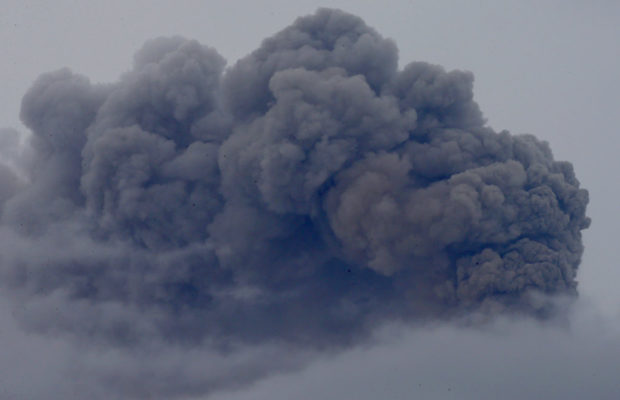Phivolcs warns of catastrophic mudflow from Mayon

Cloud-shrouded Mayon volcano erupts anew as seen in Legazpi city, Albay province, around 340 kilometers (200 miles) southeast of Manila, Philippines, Sunday, Jan. 28, 2018. Mayon’s lava fountaining has flowed up to more than 3 kilometers (1.9 miles) from the crater in a dazzling but increasingly dangerous eruption. (AP Photo/Bullit Marquez)
LEGAZPI CITY — The threat of catastrophic mudflow is building on the slopes of Mount Mayon where nearly 90,000 residents have been moved out of harm’s way, authorities said on Tuesday.
Mayon has spewed millions of tons of ash, rocks, lava and debris in less than three weeks, much of it loosely lodged on its burnt slopes and which experts warn could be dislodged by heavy rain.
Activity continued overnight with “energetic lava effusion,” while previously extruded lava was also collapsing on the crater, only to be pushed out again as debris, the Philippine Institute of Volcanology and Seismology (Phivolcs) said in its latest bulletin.
Loud booming sounds, like that of thunder, accompanied the eruptions, according to an Agence France-Presse (AFP) photographer near the mountain.
“The public is strongly advised to be vigilant and desist from entering the 8-kilometer radius danger zone, and to be additionally vigilant against pyroclastic density currents, lahar and sediment-laden stream flows,” the bulletin said.
Article continues after this advertisementPyroclastic currents are the superheated clouds of gas, ash and other volcanic debris that burn everything in their path as they speed down the slopes of the 2,460-meter volcano in Albay province.
Article continues after this advertisementThe institute said these materials were building blocks for lahar mammoth debris flows that could find their way into streams and rivers and mow down surrounding communities.
An earlier Mayon eruption passed without any casualties in 2006, but four months later a typhoon unleashed an avalanche of volcanic mud from its slopes, killing about 1,000 people.
On Saturday, Phivolcs issued its first lahar warning on Mayon this year due to incessant rain that is usual in the region at this time of the year.
A day later, Phivolcs made a video recording of lahar flowing down a river near Daraga town south of the volcano, though it did not cause any damage or casualties.